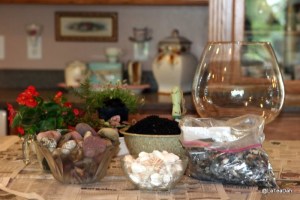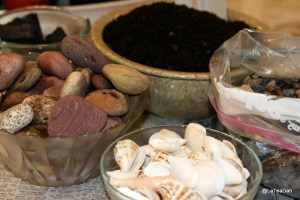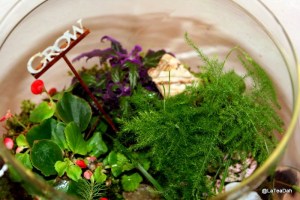Saturday, March 12, 2011
Bringing Nature Indoors
One of my favorite authors writes that “nature study should be an important part of your child’s daily program. This may include working with plants, pots, or window boxes indoors, or a bigger garden outdoors; collecting, identifying, and classifying leaves, rocks, shells, etc.; starting a nature experiment; or taking a walk to see what can be found to study.” [Home Grown Kids, p. 154]
Sometimes weather conditions, living conditions, and circumstances make daily nature study difficult. Videos, pictures, books, etc. can fill the gap, but when a child or adult finds something live to touch, see, and experience, natures lessons are clearly illustrated at the highest levels of learning and comprehension. Let’s explore one way that nature can be studied in a controlled environment in the home.
Bringing nature into the house is fun and a fresh way to see how things grow in their own, self-contained ecosystem. A terrarium can be made out of a variety of glass containers and are a beautiful addition to any living space. To make a terrarium you will need:
1) Natural materials from nature: if possible, take a walk in the woods or along a creek bank to gather small plants and objects (violets, wild ginger, moss, rocks, twigs). Visit a plant nursery and/or the plant and flower department at the supermarket. Select and buy several small houseplants (2″ containers or 6-pack containers).
2) Purchase or gather materials for the foundation. You will need to layer, in this order, charcoal, gravel, and potting soil.
3) Find a container that is large and clear with an open top. WalMart has brandy snifters and clear glass vases that will work for a terrarium. A fish bowl or fish tank also works nicely. After experienced has been gained in building terrariums, you might want to use a large, commercial-style glass water bottle. The opening is small, but with a straightened, wire coat hanger, you can place plants and objects in the container to create a beautiful terrarium.
4) Make sure your glass container is sparkling clean. It is more difficult to polish the glass after it is filled with soil and plants.
5) Then, place a layer of charcoal in the base of the container. If using purchased charcoal, be sure it is a type that does not have chemicals or petroleum added. If the charcoal is in lumps, place it in a plastic bag and then pound it with a heavy glass or hammer to break into small pieces or powder. The charcoal acts as a purifier to absorb toxins and mold.
6) Next, add a layer of gravel, covering the charcoal completely. The gravel creates a bed for drainage.
7) Now it is time to add a layer of potting soil. This will be a thicker layer than the charcoal or gravel. Smooth it throughout the container. It does not need to be level. Instead, a mound or a slope can be created for the scene.
8) Plan the scene, deciding upon the placement of plants. At this point, a decision to make a pond or stream in the scene should be made. They can be added by placing a small, low dish on the soil in the terrarium, or by placing a small mirror or aluminum foil for the illusion of water. Working with odd numbers of plants is recommended for artistic effect and should be used to create the anchor for the scene. Smaller plants can then be added to complete the design. Using odd numbers is still recommended. Sometimes it is difficult to reach into the bottom of the container to dig holes for the plants. A table knife or a long handled iced tea spoon work as helpful tools for planting. Moss can be added in open spaces between plants to create
ground cover.
9) Add objects from nature to create a natural scene. Stones, twigs, and sea shells add contrast to the plants and create interest and ‘spark’.
10) Add small figurines or toys to add interest. Ceramic or plastic animals, Lego creations, tiny toy boats, a toy helicopter, or figurines of people make a terrarium interesting to children. A little twig cabin or house inside also sparks imagination.
11) A terrarium is a great habitat for little critters found in nature. Frogs, toads, salamanders, and chameleons will enjoy the moist and lush place to live. Insects like ladybugs or worms also give life to the habitat.
12) A terrarium is a closed habitat when a cover is added to the top. If an aquarium is used, a mesh cover that fits tightly can be purchased. For a glass vase or brandy snifter, a plate set on top works to keep moisture inside. Watering will not be necessary very often because the moisture will recycle in the container, forming condensation on the sides. Observing this is a great opportunity to teach the cycle of water to the ocean, clouds, and rain. Sometimes a terrarium can become too moist, so keep watch and slide the plate aside to make a small crack for moisture to escape. If it becomes too moist, the plants will rot and spoil.
A terrarium can be used to teach lessons from nature and to spark the interest and imagination of the children who craft and observe what’s inside. Seeing how plants grow or how they need trimmed so they don’t overgrow the container involves the child actively on a daily basis. Gathering new objects can be done on daily walks and the child can add or remove things from the scene to improve it or to keep up with the seasons. Its interactive nature is especially observed when little critters are added. The terrarium as a self-contained habitat can provide hours of involvement in learning for the child and can give them the opportunity to observe nature up close and naturally in their home environment. It’s a great way to involve the family in a fun and beautiful nature activity.
Subscribe to:
Post Comments (Atom)









No comments:
Post a Comment